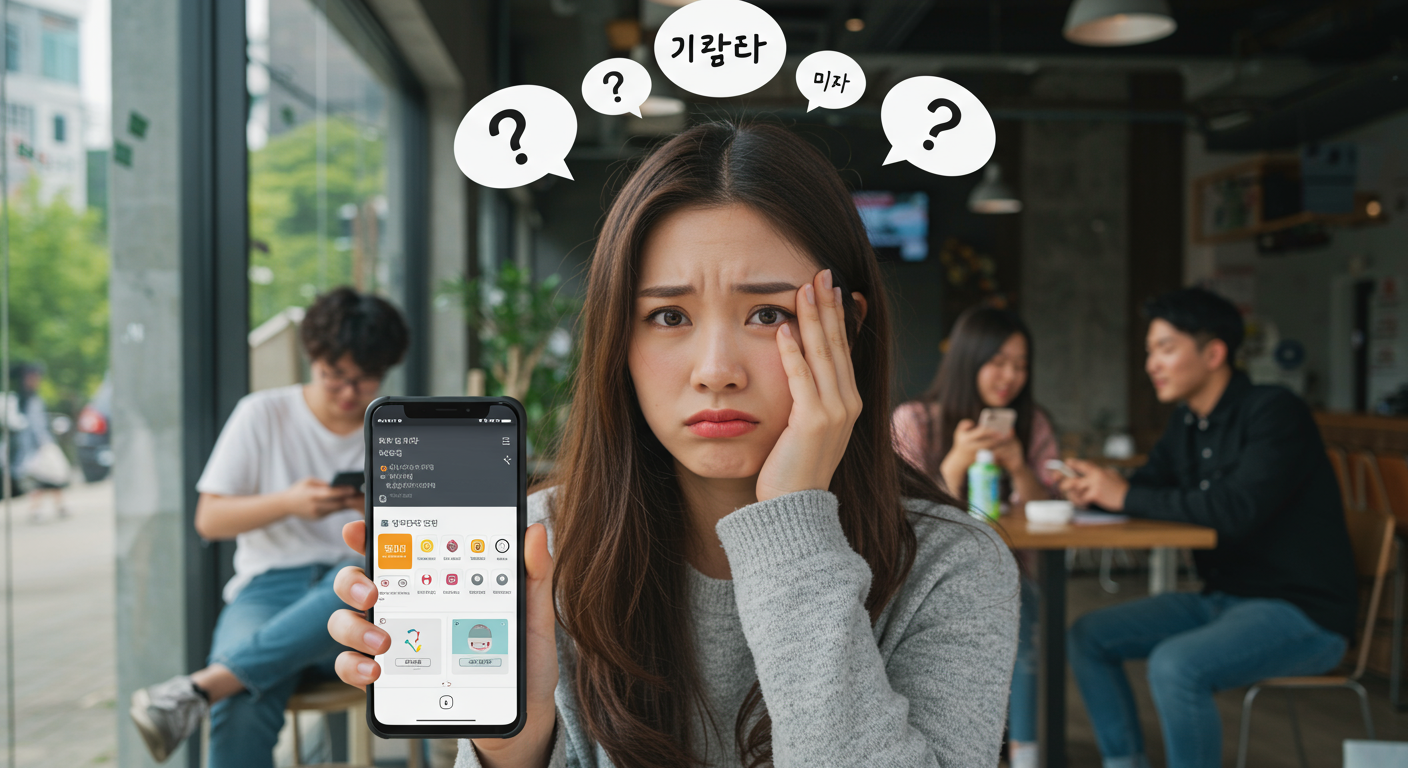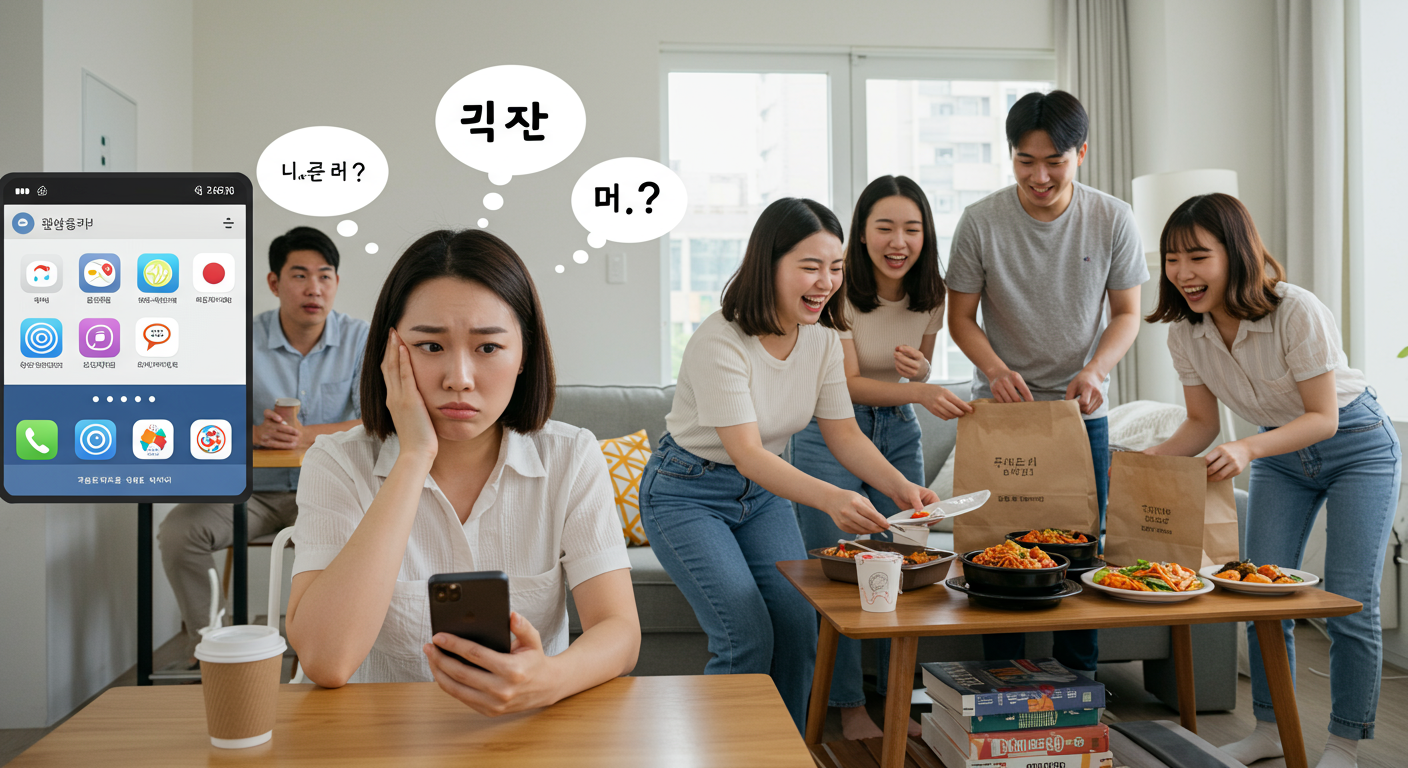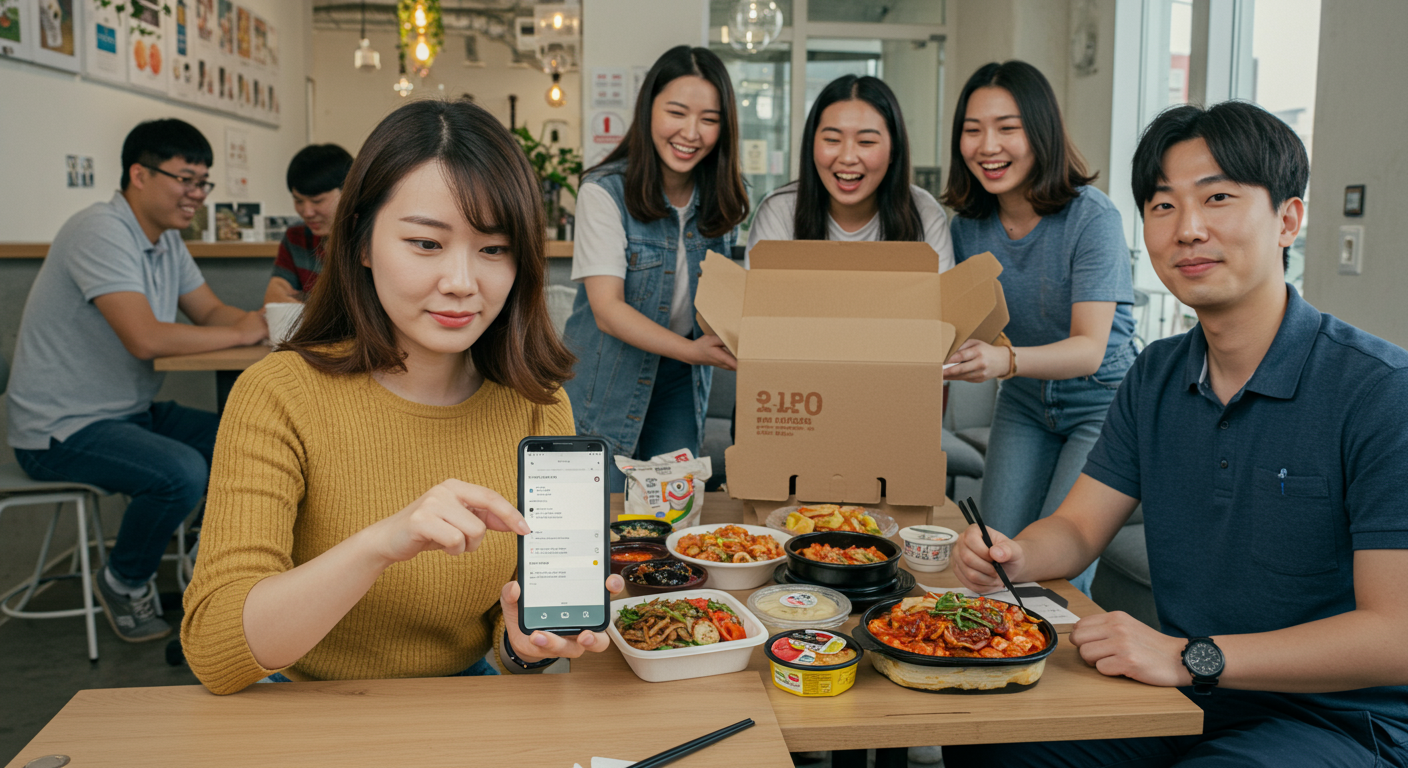Unlocking Korea: Essential Services for a Seamless Foreigner Life
Unlocking Korea: Essential Services for a Seamless Foreigner Life
Ever felt lost trying to order food or pay for something online in Korea, despite the amazing tech? You're definitely not alone.
When I first moved to Korea, I was absolutely thrilled by the vibrant culture and incredible efficiency. But then reality hit: the language barrier and the unique online payment systems. It felt like navigating a beautiful, complex maze! For anyone visiting, studying, or living here, these little daily hurdles can turn into big frustrations. That's why I've put together this guide – to share the convenient services that genuinely made my life, and countless others', so much easier. Consider this your personal cheat sheet to thriving in the Land of the Morning Calm. Trust me, it gets easier!
Table of Contents
 Description: "A foreign woman (20s-30s) looking slightly overwhelmed by complex Korean app screens, with thought bubbles showing question marks and Korean characters. Realistic photo style, slightly frustrated but determined expression."
Description: "A foreign woman (20s-30s) looking slightly overwhelmed by complex Korean app screens, with thought bubbles showing question marks and Korean characters. Realistic photo style, slightly frustrated but determined expression."
Overcoming the Language & Payment Maze: Why Korea Feels Tricky
Let's be real: Korea is amazing, but sometimes it feels like they’ve built a completely separate digital ecosystem just for themselves. When I first arrived, I found myself in countless situations where I just wanted to buy a coffee or order dinner, and the sheer confusion of the payment system and the Korean-only interfaces was enough to make me want to give up. I mean, why do so many websites require ActiveX or specific Korean bank certificates just to complete a simple transaction? It’s truly baffling for anyone used to seamless international payments.
The language barrier, of course, is the other big one. Ordering food, figuring out bus routes, or even just signing up for a gym membership often meant pulling out Papago or trying to guess which button to press. It’s not always about grand, complex conversations; sometimes, it’s just about knowing how to get a simple task done without feeling completely lost. But don't worry, there are some fantastic services that bridge this gap, turning those frustrating moments into genuinely convenient experiences. I promise, it gets better, and you’ll soon be navigating Korea like a pro!
Food & Groceries Made Easy: No More Hunger Games!
When hunger strikes in Korea, you're in luck! The food delivery scene here is unparalleled. But for foreigners, it can be a bit of a hurdle. My first successful food delivery order felt like winning a minor lottery – it was pure triumph! Here’s what helped me conquer the craving.
Food Delivery Apps with English Support
For many, food delivery is an everyday convenience. Here are the top players and how they cater to foreigners:
| App Name | Key Features | Foreigner Friendly Aspects |
|---|---|---|
| Coupang Eats | Fast delivery, wide restaurant selection. | Part of the Coupang ecosystem (if you have an account), sometimes offers English menus. |
| Shuttle Delivery | Dedicated English service, international card support. | Designed for foreigners, English customer service. |
| Yogiyo | Popular choice, many restaurants, frequent promotions. | Korean interface, but can be navigated with Papago; some restaurants may have English names. |
Grocery Delivery Solutions
Groceries can be even more daunting than food, especially with all the unfamiliar product names. But don't despair:
- Coupang (Rocket Fresh/Rocket Delivery): If you live in Korea, you've probably heard of Coupang. They're a lifesaver for groceries. Rocket Fresh delivers fresh food, often within hours, and Rocket Delivery for almost anything else. Their app is primarily Korean, but with a little practice and Papago, you can navigate it pretty well.
- Market Kurly: Known for its high-quality, fresh produce and gourmet items, Market Kurly also offers convenient early morning deliveries. Again, mostly Korean, but worth the effort for their unique selection.
 Description: "A diverse group of young adults (20s-30s, international students/expats) happily unboxing a food delivery order from a Korean app in a modern apartment living room, with a variety of Korean dishes on the table. Bright, warm lighting. Realistic photo style."
Description: "A diverse group of young adults (20s-30s, international students/expats) happily unboxing a food delivery order from a Korean app in a modern apartment living room, with a variety of Korean dishes on the table. Bright, warm lighting. Realistic photo style."
Seamless Commuting & Travel: Your Personal Navigator
Getting around Korea is incredibly efficient, but figuring out the routes and transport options can be a headache, especially for new arrivals. Forget Google Maps for public transport here; local apps are king!
Navigation and Public Transport Apps
- Naver Map & Kakao Map: These are your go-to navigation apps. While mostly in Korean, Naver Map does offer an English interface and is generally more accurate for public transport and walking directions. Kakao Map is also excellent, especially for finding bus stops and real-time bus information. I remember being so proud of myself for successfully navigating a complex subway transfer using Naver Map for the first time!
- T-Money Card: An absolute must-have! This rechargeable card works on all public transport (subways, buses, taxis) and even in some convenience stores. You can buy and recharge it at subway stations and convenience stores. It truly simplifies payments and makes daily commuting stress-free.
- Kakao T: For ride-hailing, Kakao T (카카오 T) is the dominant app, essentially Korea's Uber. It offers various taxi options, including international taxis. You can link your foreign credit card, which is a huge plus!
Travel Booking for Foreigners
For booking tours, tickets, or unique experiences, is fantastic. It's designed specifically for international travelers, offering a wide array of activities across Korea with easy booking and payment in English. It's a lifesaver for planning weekend trips or special outings!
 Description: "A foreign man (30s) confidently using a navigation app on his phone at a busy Seoul subway station, with a vibrant, clean subway train in the background. Dynamic, bright, and slightly futuristic photo style."
Description: "A foreign man (30s) confidently using a navigation app on his phone at a busy Seoul subway station, with a vibrant, clean subway train in the background. Dynamic, bright, and slightly futuristic photo style."
Staying Connected: SIM Cards & Internet Solutions
In a country where being connected is almost a survival skill, getting a reliable SIM card or internet access is paramount. The moment I got my Korean SIM card, I felt an immense sense of relief – suddenly, everything became just a little bit easier.
SIM Cards & eSIMs
Major carriers like KT, SKT, and LG U+ offer various plans for foreigners:
- Prepaid SIMs: Ideal for short-term visitors or those who prefer flexible plans. You can often purchase these at the airport or major convenience stores.
- Monthly Plans: If you're staying longer, a monthly plan might be more cost-effective. These usually require an Alien Registration Card (ARC) and a local bank account.
- eSIMs: A fantastic option if your phone supports it, allowing you to activate a plan without a physical SIM card. Many providers now offer eSIM services that can be set up before you even arrive in Korea.
Pocket Wi-Fi
For groups or those with multiple devices, a pocket Wi-Fi router (often rentable at the airport) can be a convenient alternative. It provides unlimited internet access for several devices, which is pretty handy. The only downside? You have to remember to charge it!
Handling Everyday Errands: From Banking to Parcel Delivery
Beyond food and travel, daily life in Korea involves a fair share of errands. And guess what? There are services to make those easier too!
Banking for Foreigners
Opening a bank account can be tricky without an ARC and sometimes even trickier with. However, some banks are much more foreigner-friendly:
- Woori Bank & Kookmin Bank: Both have dedicated "Global Branches" in major cities with English-speaking staff. They're often the easiest for new residents to open accounts and get set up with online banking. My first trip to Woori Bank's global branch felt like a breath of fresh air after struggling with local branches.
- Toss Bank & KakaoBank: These are online-only banks. While they offer incredibly convenient services (and sometimes easier account opening for those with ARCs), their apps are predominantly in Korean. Once set up, though, they’re fantastic for quick transfers and payments.
Parcel Delivery & Translations
 Description: "A friendly Korean bank teller (40s-50s, female) assisting a foreign customer (20s-30s, male) with a tablet, demonstrating banking app features. The setting is a clean, modern bank branch. Realistic, warm, and helpful atmosphere."
Description: "A friendly Korean bank teller (40s-50s, female) assisting a foreign customer (20s-30s, male) with a tablet, demonstrating banking app features. The setting is a clean, modern bank branch. Realistic, warm, and helpful atmosphere."
My Top Tips for Thriving in Korea
Living in Korea as a foreigner can be an incredible adventure, full of unique experiences and endless discoveries. It’s not always easy, but with the right mindset and a few helpful tools, you can truly thrive. Based on my own journey, here are a few parting thoughts:
"Patience is your best friend when navigating a new culture, especially one as digitally advanced yet uniquely localized as Korea."
Embrace the Local Apps: Seriously, this is the biggest game-changer. While Google might be your comfort zone, Naver and Kakao are the true kings here. Download them, play around with them, and slowly, surely, they'll become second nature.
Don't Be Afraid to Ask for Help: Koreans are generally very kind and willing to help, especially when they see you're trying. A simple "Jeogiyo?" (저기요?) to get attention, followed by a confused look and pointing at your phone, can often work wonders. Or, try finding online communities for foreigners in Korea – they're a treasure trove of shared wisdom.
My hope is that this guide gives you the confidence to dive deeper into Korean life, without the constant worry of getting stuck on a payment screen or lost on a bus. Korea is waiting for you to explore it, effortlessly!
Frequently Asked Questions (FAQ)
While many major stores and restaurants accept international credit cards (Visa, Mastercard), you might encounter issues with smaller shops, some online services, or specific Korean payment gateways. Having some cash or a T-Money card loaded with funds is always a good idea, especially for public transport and smaller purchases.
While many services are primarily in Korean, the apps and platforms mentioned in this guide (like Shuttle Delivery, Trazy, and Naver Map's English interface) aim to make things easier for non-Korean speakers. Using translation apps like Papago is also a huge help. You don't need to be fluent, but learning basic phrases certainly enhances your experience!
If you're a short-term visitor or haven't received your ARC yet, you can opt for a prepaid SIM card or an eSIM from major carriers. Many tourist-oriented services at the airport or online platforms like Trazy (which often partner with telecom providers) offer these options specifically for foreigners without an ARC. Just be aware that some Korean apps or services require an ARC-linked phone number for full verification.
Comments
Post a Comment